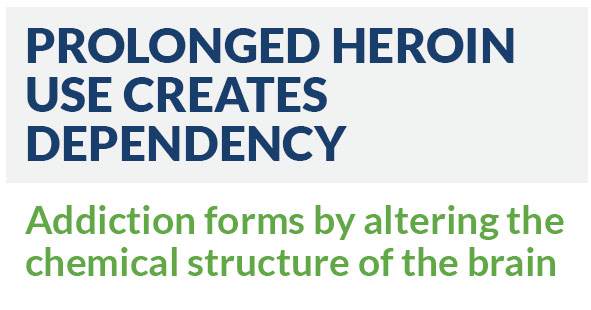HEROIN AND THE BRAIN

Heroin is considered one of the world’s most addictive substances because of its hypnotic effect on the brain. When snorted or injected, heroin almost instantaneously activates neurotransmitters associated with pleasure, otherwise known as the brain’s “feel good” chemicals. Although dopamine is the primary neurotransmitter involved in the heroin “high,” serotonin is also involved, as are a number of lesser-known neurochemicals. Together, these chemicals comprise the brain’s “pleasure and reward system.” Prolonged heroin use creates dependency and, ultimately, addiction by altering the entire chemical structure of this intricate and extremely delicate system— in effect, rewiring the brain.

Over time, and with increasing frequency and dosage, the brain tries to self-preserve by shutting down its production of neurochemicals, a process that drives users to even more irrational extremes in their attempt to sustain the same high. In some cases, brain functioning eventually returns to normal after appropriate treatment, although dysfunctional effects still remain. In other cases, the brain damage sustained is permanent and the loss of gray matter, neural synapses, receptors, and pathways too great to overcome. Either way, heroin manipulates, assaults, and alters the brain and your mental health in incredibly risky and potentially deadly ways.

WHY HEROIN KILLS
Regardless if someone is addicted or not, heroin is particularly damning to cardiovascular health. Heroin use, even in mild doses, can lead to general cardiovascular distress, arrhythmia, pulmonary edema, and collapsed veins. All of these medical terms describe restricted blood flow and the heart’s inability to pump blood to the veins, a process that can cause a heart attack. In extreme cases, the body dies from lack of oxygen, strangled by its own inability to breathe.
Heroin-related overdose deaths are frequently caused by lack of oxygen to the brain— a phenomenon known as
hypoxia. Depending upon how long the brain is deprived of oxygen, symptoms of
hypoxia may include:
- Lack of coordination
- Disorientation
- Impaired vision and/or hearing
- Dangerously vegetative state
- Inability to concentrate
- Coma
- Death
Beyond heroin’s significant cardiovascular dangers, other long-term effects include damage to oral and skin health. Heroin decays teeth, causes painful, bleeding oral abscesses, creates jaw bone mass and density loss, burns fingers (from injection and injection paraphernalia), and prematurely cracks, wrinkles and yellows skin. Heroin’s deadly effects are often clearly visible in long-term users whose pale, sickly and prematurely aged complexion is at once terrifying and frail.
To put the magnitude of the heroin epidemic into proper proportion, consider the following facts:
- According to the National Institute for Drug Abuse (NIDA), heroin use has surged among 18-25 year olds, a psychologically and physiologically vulnerable population. When compared to surveys taken between 2002 and 2004, heroin use doubled between 2011 and 2013, representing a 53 percent increase.
- The uptick in heroin initiation numbers applied to all socioeconomic statuses and both genders, with females representing a 100 percent increase.
- Between the years 2002 and 2013, heroin overdose deaths skyrocketed, representing a whopping 286 percent increase. This steady incline in just over a decade has showed little signs of stopping, with new statistics showing either a plateau or only slight decline.
- Heroin is a significant part of the opiate death toll that claims 115 American lives daily and approximately 42,000 annually, a trend that is steadily increasing.
GETTING HELP FOR HEROIN ADDICTION
Approximately one-quarter of heroin users develop dependency and subsequent addiction. Heroin is an extremely dangerous and debilitating drug; therefore, a
professional detox and treatment program is absolutely necessary.
Upon the successful completion of a detox program, clients typically receive treatment in an intensive residential or outpatient setting. There, they can receive the evidence-based benefit of medication-assisted treatment (MAT), which is proven to reduce heroin cravings and lower relapse rates. Reputable programs will be able to verify insurance coverage and benefits prior to enrollment. They also offer an impressive variety of ancillary services designed to help clients transition back into healthy and autonomous sober functioning after rehab.
If you or someone you love is struggling with heroin addiction, call a substance abuse professional today. Never delay the process.
Heroin is lethally potent, and time is a luxury you cannot afford.
 For more information about heroin addiction and recovery, check out these related articles:
Sources:
Journal of Addictive Behaviors. Increased use of heroin as an initiating opioid of abuse. Nov, 2017.
American Journal of Nursing (AJN). Heroin and Nalaxone. Oct, 2014.
PLOS ONE. The societal cost of heroin use disorder in the United States. May, 2017.
Journal of Emergency Nursing. The Heroin Epidemic and Emergency Nurses. Nov, 2014.
Journal of the American Medical Association (JAMA). The Changing Face of Heroin Use in the United States. July, 2014.
American Journal of Preventative Medicine (AJPM). Geographic Variation in Opioid and Heroin Involved Drug Poisoning Mortality Rates. Dec, 2017.
For more information about heroin addiction and recovery, check out these related articles:
Sources:
Journal of Addictive Behaviors. Increased use of heroin as an initiating opioid of abuse. Nov, 2017.
American Journal of Nursing (AJN). Heroin and Nalaxone. Oct, 2014.
PLOS ONE. The societal cost of heroin use disorder in the United States. May, 2017.
Journal of Emergency Nursing. The Heroin Epidemic and Emergency Nurses. Nov, 2014.
Journal of the American Medical Association (JAMA). The Changing Face of Heroin Use in the United States. July, 2014.
American Journal of Preventative Medicine (AJPM). Geographic Variation in Opioid and Heroin Involved Drug Poisoning Mortality Rates. Dec, 2017.

 Heroin is considered one of the world’s most addictive substances because of its hypnotic effect on the brain. When snorted or injected, heroin almost instantaneously activates neurotransmitters associated with pleasure, otherwise known as the brain’s “feel good” chemicals. Although dopamine is the primary neurotransmitter involved in the heroin “high,” serotonin is also involved, as are a number of lesser-known neurochemicals. Together, these chemicals comprise the brain’s “pleasure and reward system.” Prolonged heroin use creates dependency and, ultimately, addiction by altering the entire chemical structure of this intricate and extremely delicate system— in effect, rewiring the brain.
Heroin is considered one of the world’s most addictive substances because of its hypnotic effect on the brain. When snorted or injected, heroin almost instantaneously activates neurotransmitters associated with pleasure, otherwise known as the brain’s “feel good” chemicals. Although dopamine is the primary neurotransmitter involved in the heroin “high,” serotonin is also involved, as are a number of lesser-known neurochemicals. Together, these chemicals comprise the brain’s “pleasure and reward system.” Prolonged heroin use creates dependency and, ultimately, addiction by altering the entire chemical structure of this intricate and extremely delicate system— in effect, rewiring the brain.
 Over time, and with increasing frequency and dosage, the brain tries to self-preserve by shutting down its production of neurochemicals, a process that drives users to even more irrational extremes in their attempt to sustain the same high. In some cases, brain functioning eventually returns to normal after appropriate treatment, although dysfunctional effects still remain. In other cases, the brain damage sustained is permanent and the loss of gray matter, neural synapses, receptors, and pathways too great to overcome. Either way, heroin manipulates, assaults, and alters the brain and your mental health in incredibly risky and potentially deadly ways.
Over time, and with increasing frequency and dosage, the brain tries to self-preserve by shutting down its production of neurochemicals, a process that drives users to even more irrational extremes in their attempt to sustain the same high. In some cases, brain functioning eventually returns to normal after appropriate treatment, although dysfunctional effects still remain. In other cases, the brain damage sustained is permanent and the loss of gray matter, neural synapses, receptors, and pathways too great to overcome. Either way, heroin manipulates, assaults, and alters the brain and your mental health in incredibly risky and potentially deadly ways.

 For more information about heroin addiction and recovery, check out these related articles:
For more information about heroin addiction and recovery, check out these related articles:




